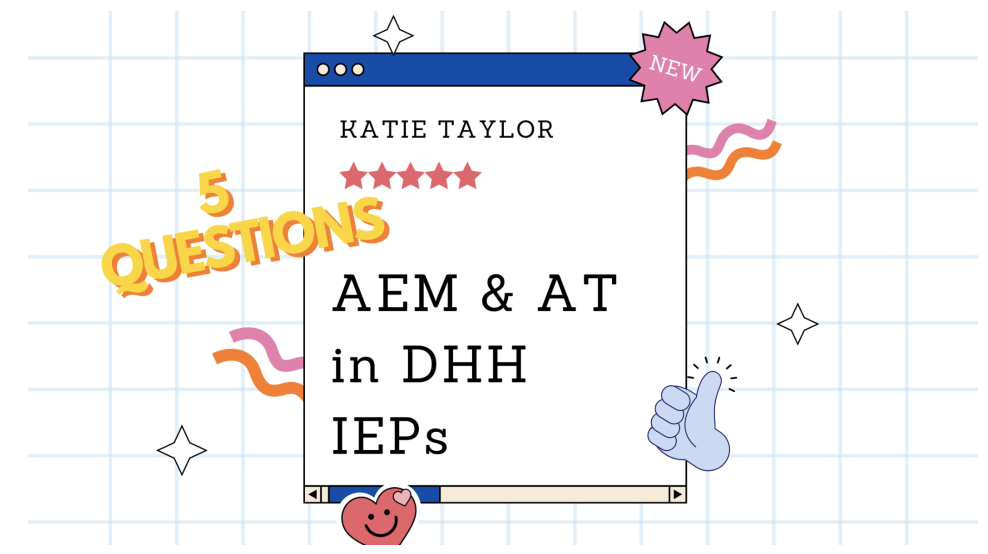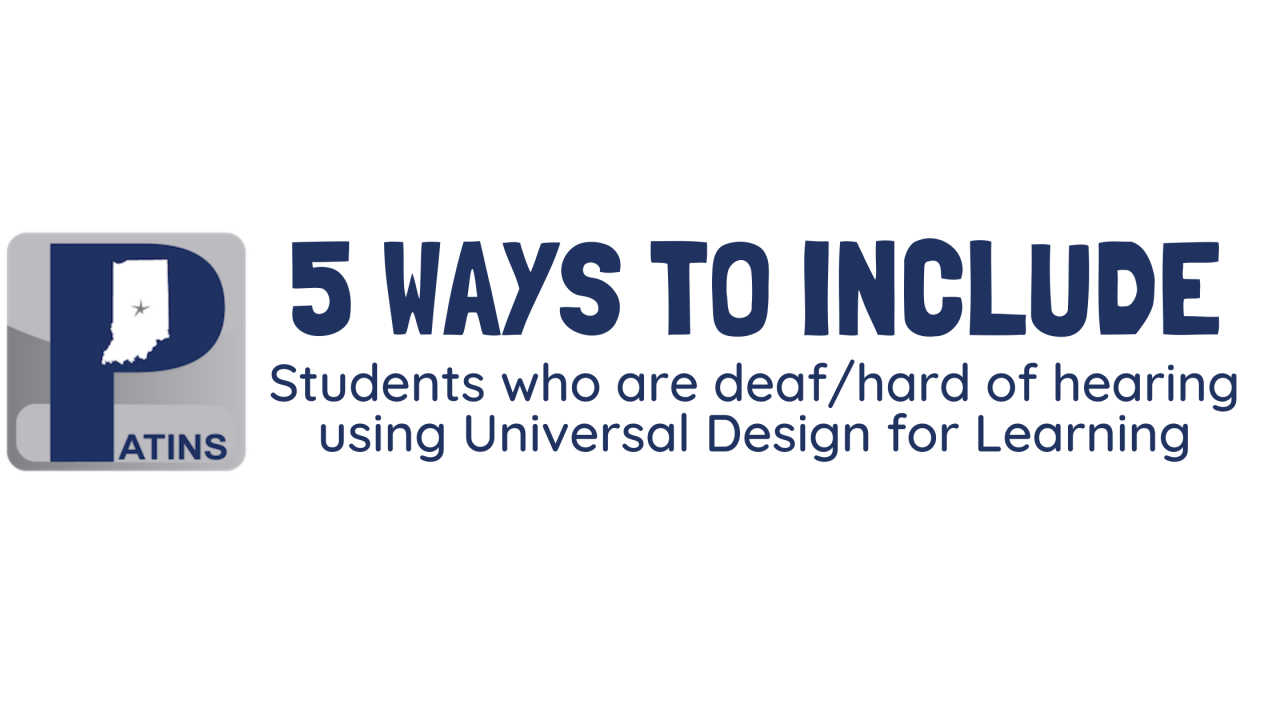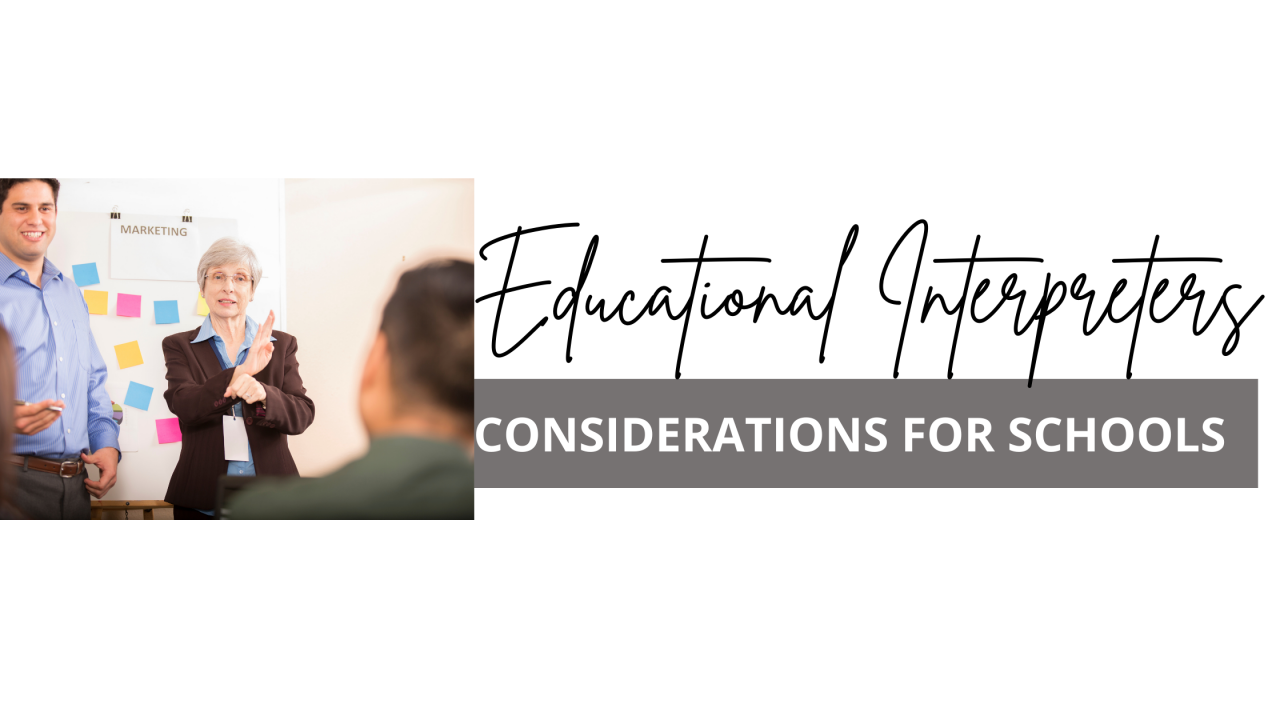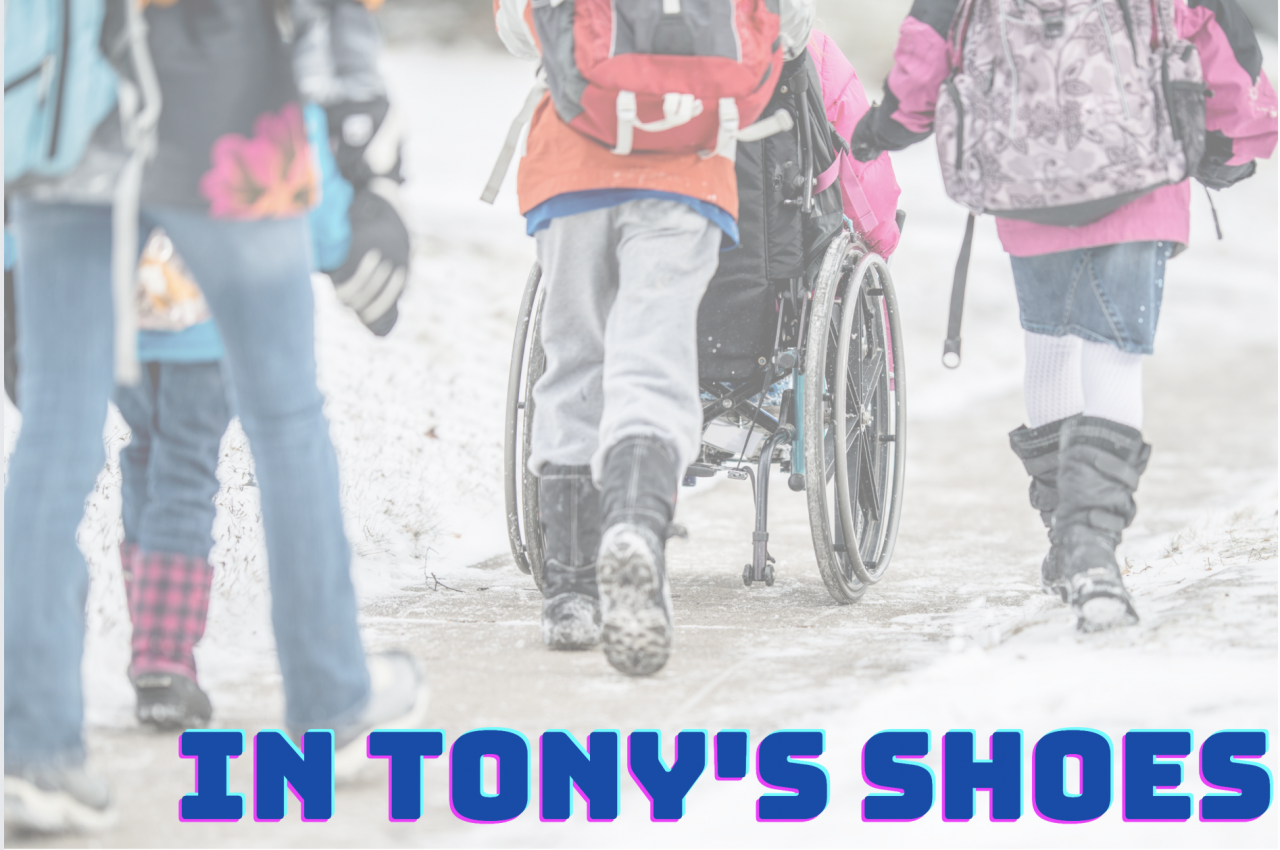- Where are AEM and AT located in the Indiana IEP system?
- Provisions and Services page
What could be considered AEM for DHH Students?
- Any materials used in the classroom that need to be in an accessible format for the student to access their curriculum at the same time as their peers such as closed and open captions, transcripts in (but not limited to) foreign language learning classrooms, access to print material in digital formats (This is not an exhaustive list).
- What could be considered AT for DHH Students?
- Any device or technology used to provide access to the curriculum such as a tablet or Chromebook/laptop for access to live transcript applications, AAC device, FM/DM ear level transmitter/receiver, t-coil, neck loop, induction loop, remote mini microphone, Bluetooth device, built-in or stand-alone sound-field speaker and microphone, book clips, speech to text software/applications, text to speech software/applications (This is not an exhaustive list).
- Even if the case conference committee decides that the student does not need AEM and/or AT to provide FAPE do we select “No” and leave the box blank?
- When a case conference committee decides that the student does not need either AEM or AT to provide FAPE then select “No” in the appropriate box and comment in the box on what was considered, discussed, and the outcome.
- Note: Leaving the box blank can suggest that the team did not consider or discuss AEM or AT during the conference.
- How can our team determine if AEM and/or AT are appropriate for our DHH student(s)?
- Use SETT framework (page 40), Functional Listening Evaluation, Your District’s AT team, PATINS Lending Library, and/or Consult with Katie Taylor, a state-wide PATINS Specialist in deaf/hard of hearing
Welcome back to School! While you are planning your seating charts, prepping lunch option boards, and digital homework options take a peek below at 5 easy tips to make sure you are universally including access to the curriculum and participation for all students in your classroom this year.
Printable Poster to share at your case conferences and beginning of the year in-services. Thumbprint image of the poster below. 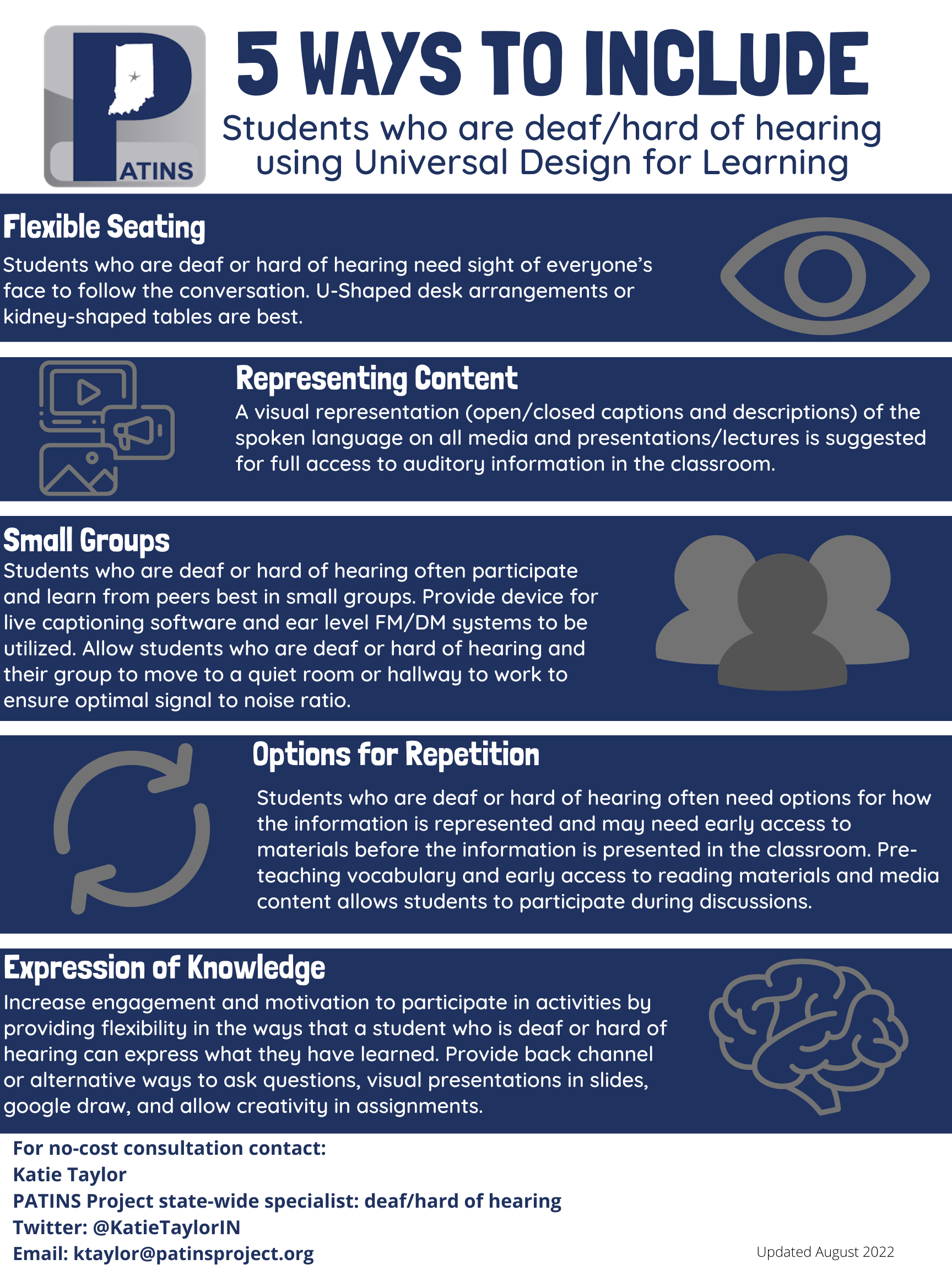
- Flexible Seating: Students who are deaf or hard of hearing need sight of everyone’s face to follow the conversation. U-Shaped desk arrangements or kidney-shaped tables are best.
- Representing Content: A visual representation (open/closed captions and descriptions) of the spoken language on all media and presentations/lectures are suggested for full access to auditory information in the classroom.
- Small Groups: Students who are deaf or hard of hearing often participate and learn from peers best in small groups. Provide device for live captioning software and ear level FM/DM systems to be utilized. Allow students who are deaf or hard of hearing and their group to move to a quiet room or hallway to work to ensure an optimal signal-to-noise ratio.
- Options for Repetition: Students who are deaf or hard of hearing often need options for how the information is represented and may need early access to materials before the information is presented in the classroom. Pre-teaching vocabulary and early access to reading materials and media content allow students to participate in discussions.
- Expression of Knowledge: Flexibility in the ways that a student who is deaf or hard of hearing can express what they have learned will increase engagement and motivation to participate in activities. Provide back channel or alternative ways to ask questions, visual presentations in slides, google draw, etc.
If you and your team need suggestions on implementing any of the above please do not hesitate to contact Katie Taylor, PATINS Project’s deaf/hard of hearing state-wide specialist at ktaylor@patinsproject.org.
This week's blog is brought to us by our guest blogger and Language First founder, Kimberly Sanzo, MS, CCC-SLP, BCS-CL. Kimberly's biography is at the bottom of this blog.
Educational interpreters are an important part of the educational team and their work in providing language accessibility for Deaf and hard of hearing (DHH) students is critical. However, it’s important for school districts contemplating hiring an American Sign Language (ASL)-English interpreter for their DHH student(s) to consider a few vital factors. First, what is the language level of the DHH student? If the student has strong signed language skills, they may benefit from having the academic information interpreted into a visual language. If, however, the student has strong oral language skills and minimal signed language skills, then perhaps there needs to be a discussion as to the ultimate goal of having an educational interpreter in the classroom. If the goal is for the student to learn some ASL, then simply being provided an interpreter will not help them acquire a new language. Educational interpreters do not provide language instruction, and it would not be fair to expect the DHH student to attempt to acquire a new language while simultaneously trying to take in academic information. Additionally, having information interpreted into a language they barely know will likely be unhelpful.
Most crucially, if the student has minimal signed language skills and minimal oral language skills, an interpreter may not be beneficial. In fact, providing an educational interpreter to a DHH child with no complete first language may be more harmful than helpful. As Caselli et al. (2020) assert, there is no evidence that DHH children with language deprivation can overcome their language difficulties from a single language model, even if that model is fluent in the language. School-aged DHH children without fluency in any language will not be able to simply acquire a signed language from an educational interpreter. Rather, they need intensive and purposeful language intervention in their most accessible language as well as plenty of language models and same-language peers with which to interact.
Another important consideration is the skill level of the educational interpreter. In a study by Schick et al. (2005), the authors found that 60% of the interpreters evaluated did not have the skill level necessary to provide DHH students with full access to the curriculum. This may be a result of state-by-state variation in requirements for interpreter skill levels. Many states don’t have standard requirements for educational interpreters, while others have standards that are gravely below the needs of DHH students (National Association of Interpreters in Education, 2021). Thus, it is critical that the school properly vet ASL-English interpreters who may be working with their students by ensuring they have an objective measure of adequate skill level.
This is vital for a few reasons. First, interpreters themselves may not be able to accurately estimate their skills. This is due to a human cognitive fallacy called the Dunning-Kruger Effect, or the tendency for less-skilled individuals to rate themselves as highly skilled, and highly skilled individuals to rate themselves as less skilled. Indeed, Fitzmaurice (2020) found that the least skilled interpreters overestimated their skills, while the most skilled interpreters underestimated their skills. Therefore, a score on a standardized test like the Educational Interpreter Proficiency Assessment (EIPA) can be helpful in offering a more objective evaluation of an interpreter’s skills. Second, less skilled interpreters are less accurately interpreting information for their DHH students (Schick et al., 2005). The lower the percentage of accurately interpreted information, the less access DHH students are getting to academic content. Indeed, Schick et al. (1999) found that “many deaf children receive an interpretation of classroom discourse that many distort and inadequately represent the information being communicated” (p. 144).
Our DHH students need and deserve 100% access to academic information at all times, just like their hearing peers. It is our responsibility to ensure that a.) the student is a good candidate for an educational interpreter (if they are not, other educational placements should be discussed), and b.) that interpreter is highly qualified to provide full language access.
References:
Caselli, N. C., Hall, W. C., & Henner, J. (2020). American Sign Language interpreters in public schools: An illusion of inclusion that perpetuates language deprivation. Maternal and Child Health Journal.
Fitzmaurice, S. (2020). Educational interpreters and the Dunning-Kruger Effect. Journal of Interpretation, 28(2).
National Association of Interpreters in Education (2021). State Requirements for EducationalInterpreters. https://naiedu.org/state-standards/
Schick, B., Williams, K., & Kupermintz, H. (2005). Look who’s being left behind: Educational interpreters and access to education for deaf and hard-of-hearing students. Journal of Deaf Studies and Deaf Education, 11(1), 3-20.
Schick, B., Williams, K., Bolster, L. (1999). Skill levels of educational interpreters working in public schools. Journal of Deaf Studies and Deaf Education, 4(2), 144-155.
Kimberly Sanzo, MS, CCC-SLP, BCS-CL
Kim is a speech-language pathologist (SLP) who is committed to educating parents and professionals on the neurological effects of a late or incomplete first language acquisition for Deaf and hard of hearing children. She received her M.S. in Speech-Language Pathology from Gallaudet University in 2012 and is a board-certified specialist in child language (BCS-CL) through the American Board of Child Language and Language Disorders.
Kim is also the founder of Language First. Language First aims to educate and raise awareness about American Sign Language (ASL)/English bilingualism and the importance of a strong first language foundation for Deaf and hard of hearing (DHH) children. You can find more information on Language First social media platforms such as Facebook and Instagram and website.
Have you ever been the new kid at school? Being the new kid, I would worry if I would like my teacher and if I would make new friends however the following article invites you to step into Tony’s shoes as the new student with a [perceived] disability in a mainstream or inclusion setting. Can you imagine if the access that Tony needs to the auditory world was just integrated and he didn’t have to advocate for it? Teachers can plan their classroom and lessons with every student in mind before they even know their students’ names with guiding principles of Universal Design for Learning (UDL) and the PATINS Project’s UDL Lesson Creator.
Read more about Tony's story and take a look at how educators can implement UDL for students who are deaf or hard of hearing in this 2020 issue of the Odyssey Magazine published by the Clerc Center National Deaf Education Center at Gallaudet University in the article, One-Stop Lesson Planning: How Universal Design for Learning Can Help Students Who Are Deaf or Hard of Hearing by Katie Taylor, PATINS Specialist.
Reference:
Taylor, K. 2020. One-stop lesson planning: how universal design for learning can help students who are deaf or hard of hearing. Odyssey Magazine. Clerc Center. https://www3.gallaudet.edu/Documents/Clerc/Odyssey/Odyssey%202000/ODYSSEY%202020%20-%20pg%2048-51%20-%20Taylor.pdf

